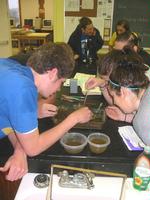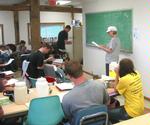Posted on Monday, April 19, 2010
The Little Neshannock Creek originates in forest and farmland of Mercer County, is fed by small streams like McClure Run that bisects Westminster's campus, and, most important for us, sets the western boundary of the Field Station. The creek itself is a laboratory.
If you had been in the vicinity on Thursday, April 8, you would have heard some strange sounds coming from the stream: "0.25" followed by "1.18" and similar numbers being called out from midstream to students huddled in the rain on the creek's bank noting the values for stream depth and water velocity.
Several other students in assorted waders and with rain coming at them in spurts could have been seen kicking up the bottom of the stream to collect samples of the benthic macroinvertebrate community, or bottom-dwelling "bugs."
This was the "Introduction to Environmental Science" class taught by Ms. Anneli TerryNelson, adjunct environmental science instructor at Westminster. Students were conducting a field lab in real-time, real weather. Fortunately, once their data and samples were collected, they quickly moved inside the Nature Center to identify their catch, analyze their data, and sip hot chocolate. All of this activity was in pursuit of a snapshot picture of the overall health of the Little Neshannock. Macroinvertebrates, as it turns out, are great indicators of water quality. Water discharge in a stream (which is calculated by multiplying the cross-sectional area of the stream by the velocity of the water) can also impact the health of a stream ecosystem and gauge water quality.
TerryNelson, in commenting on this experience, noted people learn in different ways. She expanded on this by saying, "I, for one, have always been a hands-on learner. I have to see the gills moving on the back of a mayfly before I can really grasp the effect of too much sediment in the stream on the aquatic ecosystem." She added, "The Field Station offers fantastic opportunities for my students to experience and observe firsthand many of the complex ecological relationships and themes we discuss when in the Hoyt Science Resources Center."
In addition to studying the Little Neshannock, her class has walked the Frey Nature Trail through wetland, forest, and stream to conduct an environmental scavenger hunt that provided evidence of biogeochemical cycles and processes. These experiences hone the basic skills of scientific observation and interpretation.
TerryNelson believes that studying science means doing science. "How can you possibly study environmental science (or any ecology or biology area) without going out into the natural environment?" And, she quipped, "Why look at a prepared microscope slide when you can actually walk down to a stream and study the real thing?" That's what the creek-and the Field Station-are for!
Clarence Harms, Director
Field Station
harmsc@westminster.edu


